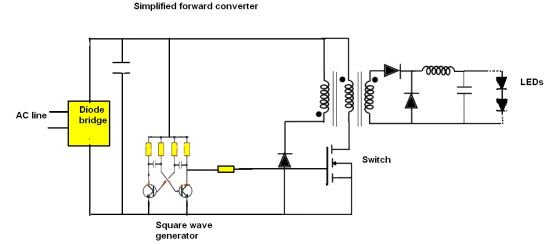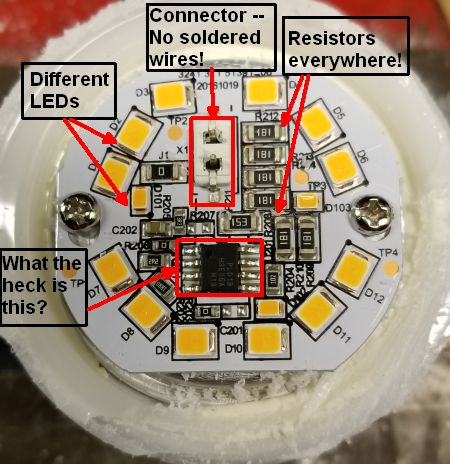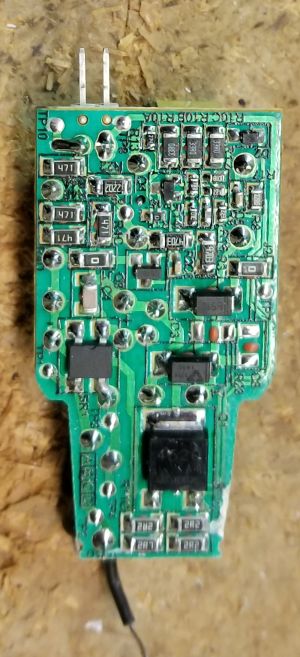LED bulbs we examined are often simpler than those made four years ago, sometimes employing discrete transistors to handle tasks once done via chips.
Leland Teschler, Executive Editor
Back in 2015, we examined LED bulbs putting out the equivalent of 60-W incandescent bulbs. We recently obtained several new LED bulbs to see how things have changed. The results are interesting. In general, the new bulbs we tore down have a much simpler mechanical construction and simpler electronics than those of four years ago. Additionally, manufacturers seem to have fewer concerns about thermal issues or generating electromagnetic interference. The bulbs we dissected have much less in the way of heat sinking or EMI shielding than their older counterparts.

Our approach for this new round of bulb tear-downs mimics that of 2015: We picked the top-rated bulbs from Consumer Reports. Fortunately, one of the bulbs we looked at made CR’s list both in 2015 and today, allowing us to make an apples-to-apples comparison. That is the SlimStyle A19 soft white dimmable bulb from Philips Lighting. This bulb is unlike most others in that its LED plates shine light out to the side rather than up. This gives it a thin profile – it’s more like a disk than a bulb — and a light emission pattern that probably works best in a lamp with a shade that helps disperse light evenly around the room (though the bulb packaging claims a 360° light pattern).
Both in 2015 and now, the Philips bulb manages thermal issues without any extra heat sinking. The only component that spreads heat is the 2.5-in.-diameter metal disk onto which the 26 LEDs mount, 13 to a side. Moreover, you might expect to see LEDs staggered on the disk such that they wouldn’t mount directly opposite each other – this mounting arrangement would also help spread heat. But the LEDs on either side of the disk sit directly opposite each other.
Both vintages of this bulb carry what seems to be a temperature-sensitive resistor on the LED plate which probably helps reduce the need for any additional heatsinking. In addition, the circuitry found on the old and new bulbs is quite similar with the exception of the single IC that the old version carried. That chip carried no identifiable markings and we theorized it was involved in dimming and driving the single power FET on the board.
The new version does away with that chip. In its place on the PCB are two small discrete transistors. That leads us to believe the IC provided a PWM drive to the power FET, and the two transistors that take its place are consistent with a circuit that can generate a square-wave drive signal.
Also on the board is a sizable transformer. It is the type of transformer that might be used for a flyback or forward converter. (As a quick review, the forward converter uses a transformer to increase or decrease the output voltage and provide galvanic isolation for the load. The transformer does not store energy during the conduction time of the switching element — transformers cannot store a significant amount of energy. Instead, energy passes directly to the output of the forward converter by transformer action during the switch conduction phase.)

So our best guess is that both the 2015 version and the most recent version of the Philips bulb drive the 26 LEDs with a forward converter that is also implementing a current source necessary for driving an LED. The modern version uses two transistors to create the pulse-width-modulated gate drive for the FET. The 2015 version used a custom IC for this task.

One final observation about the SlimStyle bulbs is that neither the old one nor the new one incorporates any kind of metal shielding for EMI. That would seem to indicate that the PWM frequencies involved must be pretty low.
We examined a second Philips LED bulb that got high ratings from Consumer Reports. This one is also dimmable and is called simply a soft white light bulb with a warm glow effect. Where the SlimStyle bulb cost about $8, this one went for a little over $6 and came in a pack of two. But though its light output is similar to that of the SlimStyle device, the electronics is quite different. We found 12 regular-sized LEDs and three smaller LEDs roughly half the size of the others all mounted on the metal LED plate. Also on this plate was an eight-pin IC carrying markings we couldn’t identify along with (weirdly, at least to us) 14 resistors and one capacitor.

It is unusual to see an LED bulb use LEDs of two different sizes. It is also unusual to see this many resistors in a switching power supply circuit, particularly in the portion of it that is in the LED output.
But the IC sitting on the LED plate is also a bit of a mystery. The power FET driving the LEDs sits on the PCB. So it is unlikely the IC sitting on the LED plate has anything to do with PWMing the FET, a typical role for ICs found in LED bulbs. This assumption is further fortified by the fact that there are but two connections between the PCB holding the bulb electronics and the LED plate. They are made through a single two-pronged connector on the LED plate. (The use of a connector is noteworthy. LED bulbs examined in 2015 usually made connections from the PCB to the LED plate via discrete wires soldered to the plate rather than with a connector.)

Placing the IC on the LED plate exposes it to the temperature rise caused by the LEDs, so it may play some role in temperature compensation and perhaps in forming a current source needed for driving the LEDs. Ditto for all the resistors on the plate. But because we can’t identify the IC, we can only speculate about what it does.
The LED drive circuit seems to be a forward converter, based on the presence of the transformer on the PCB and a single large inductor. Also two discrete transistors reside there, which would be consistent with a circuit generating square waves for use in a PWM scheme.
A further point to note is that this Philips bulb includes metallization on the inside of the plastic shell holding the PCB. One might speculate the metallization is there as a shield for EMI emissions.
Another bulb we dissected is the dimmable Sylvania 72637 12-W A19 Ultra LED light bulb which is comparatively expensive at $22 each from Amazon. We dubbed this one the hand grenade because of its shape. It carries six LED plates, one on top, the other five arranged around a big cast-metal structure with a separate translucent cover for each LED plate. Each LED plate holds six LEDs. Discrete wires connect the LED plates together and form the connections to the bulb’s PCB.
This bulb first became available in 2014, which makes it one of the first relatively affordable LED bulbs to hit the market. It’s design doesn’t seem to have been updated, and the fact that it still occupies a spot in the Consumer Reports top LED bulb list is probably a testament to its quality. Still, the construction practices it employs highlight the

changes in LED bulb design over the years. For example, you won’t find modern bulbs employing big cast-metal structures, and modern bulbs are more likely to use connectors for hooking the LED plate to the PCB.
The electronics on this Sylvania bulb are also previous generation. There is one 10-pin IC on the board with unidentifiable markings but which most likely implements a PWM drive for the two power FETs we found. There are also two small discrete transistors on the PCB, but they don’t seem to be good candidates for generating the required PWM pulse train. The presence of a transformer also indicates that a forward converter is the likely topology.
Another point to note is the presence of two beefy (though different) inductors. We’re guessing the first inductor might play a role in power factor correction, judging by its board position. The second is almost certainly part of the converter circuit.
But it’s not clear why designers decided they needed two FETs to power 36 LEDs. Still, this is a previous-generation design – they did things differently in 2014. Which also explains why it’s unlikely you’ll see any modern LED bulbs that look like hand grenades.







EMI can be a problem. I have 4 led lights on a track with a dimmer. It causes my Ecobee thermostat to switch screens when the light is dimmed.
Not all LED bulbs can be dimmed. You might check to see whether the ones you have are dimmable. Not sure what kind of hash they might generate if they see a triac-modulated power line signal when they’re not designed to work with it.